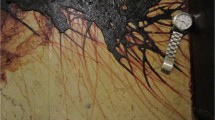Abstract
Considering that, in birds, the tongue has an important role in taking food, so its shape and morphology are affected by the nutrition method and the environment of the animal. For this study, six adult female guinea fowl were prepared and, after slaughtering them humanely, their tongues were completely removed from the oral cavity and were completely washed with distilled water. After examining the morphology and measuring the tongue area, the tissue preparation stages were used for light and electron microscopes on each case. Morphological results showed that the tongue of the guinea fowl was triangular-shaped and the average length was 21.91 mm. The tongue consisted of three parts: apex, body, and root. The average length and width of apex were 8 and 6 mm, the average length and width of body were 6 mm and 8 mm, and the average root length and width were 7 and 9 mm, respectively. The examination of the tongue by a light microscope determined that the epithelium in the three parts of the tongue was keratinized stratified squamous, and the amount of keratinized on the ventral surface was more than on the dorsal surface. The connective tissue was of the dense irregular type and the salivary glands were observed in the root and body regions. The electron microscope results showed that the dorsal surface of the tongue contains filiform papillae which were more dense in the lateral edge than middle part of the tongue. A transverse row of giant conical papillae separated the body from the root of the tongue. In the ventral surface, from the root zone to the end region of the body, a concentric transverse fine eminence can be observed to be parallel to each other, and there was a ridge on the ventral surface along the length of the tongue, which has a reduction in its height from the root toward the apex. The glands’ openings were mostly located in the root region of the tongue, and the density was higher on the dorsal surface than on the ventral surface.













Similar content being viewed by others
References
Crole MR, Soley JT (2009) Morphology of the tongue of the emu (Dromaius novaehollandiae) histological features. Onderstepoort J Vet Res 76:347–361
Ebegbulem VN (2018) Prospects and challenges to guinea fowl (Numida meleagris) production in Nigeria. Int J Avian Wildl Biol 3(3):182–184
Emura S (2016) Scaning electron microscope study on the tongues of seven avian species. Okajimas Folia Anat Jap 93(2):41–51
Fatahian Dehkordi RA, Parchami A (2010) Morphological structure comparison different areas on the tongue in native chicken shahrekord. Iranian Vet J 8(2):69–76
Igwebuike UM, Anagor TA (2013) The morphology of the oropharynx and tongue of the Muscovy duck (Cairina moschata). Veterinarski Arhiv 83(6):685–693
Jackowiak H, Godynicki S (2005) Light and scanning electron microscopic study of the tongue in the white tailed eagle (Haliaeetus albicilla, Accipitridae, Aves). Ann Anat Anatom Anzeriger 187(3):251–259
Jackowiak H, Skieresz-Szewczyk K, Kwiecinski Z, Trzcielinska-Lorych J, Godynicki S (2010) Functional morphology of the tongue in the nutcracker (Nucifraga caryocatactes). Zool Sci 27(7):589–594
Mohamadpour AA, Taherabadi M (2013) Histomorphological and developmental study of tongue in Canadian ostrich embryo (Struthio camelus). Vet J (Pajouhesh & Sazandegi) 103:37–43
Neeven E, Bakary E (2012) Scanning electron microscope study of the dorsal lingual surface of halcyon smyrnensis (white breasted kingfisher). Glob Vet 9(2):192–195
Parchami A, Fatahian Dehkordi RA (2011) Lingual structure of the domestic pigeon (Columba livia domestica) a light and scanning electron microscopic studies. Middle-East J Sci Res 7(1):81–86
Parchami A, Fatahian Dehkordi RA (2013) Light and electron microscopic study of the tongue in the white-eared bulbul (pycnonotus leucotis). Iranian J Vet 14(1):9–14
Pourlis AF (2014) Morphological features of the tongue in the quail (Coturnix coturnix japonica). J Morphol Sci 31(3):177–181
Skieresz-Sezwezyk K, Prozorowska E, Jackowiak H (2012) The development of the tongue of domestic goose from 9th to 25th day of incubation as seen by scanning electron microscopy. Microsc Res Tech 75(11):1564–1570
Funding
The authors received their financial sponsorship from the vice chancellor for research of Faculty of Veterinary Medicine and Ferdowsi University of Mashhad.
Author information
Authors and Affiliations
Corresponding author
Ethics declarations
Ethical approval
During all stages of our research, all applicable international, national, and/or institutional guidelines for the care and use of animals were followed. In addition, this article does not contain any studies with human participants performed by any of the authors.
Conflict of interest
The authors declare that they have no conflict of interest.
Additional information
Publisher’s note
Springer Nature remains neutral with regard to jurisdictional claims in published maps and institutional affiliations.
Rights and permissions
About this article
Cite this article
Tabasi, M., Mohammadpour, A.A. Light and scanning electron microscopic study of the tongue in the guinea fowl (Numida meleagris). Comp Clin Pathol 28, 613–619 (2019). https://doi.org/10.1007/s00580-019-02908-z
Received:
Accepted:
Published:
Issue Date:
DOI: https://doi.org/10.1007/s00580-019-02908-z




